How Did the Cotton Gin Affect Slavery?

One of the major effects of the cotton gin on slavery was the increased need for slaves to keep up with the profitability that came with its invention. Before the gin was invented, cotton was not considered a money-making crop.
Because removing the seeds from the cotton once it was harvested was a tedious task, it was difficult to produce cotton quickly and the crop rarely made money.
With Eli Whitney’s invention, cotton lint could be produced quickly and efficiently at up to 50 pounds per day. Plantation owners found they needed more slaves in the field to meet the increased ability of the gin. While the task of operating the gin was far less painful, the increased demand for slaves resulted in slavery raising from around 700,000 slaves in the years before its invention to nearly double that in the next two decades. Any hope that abolitionists had for a reduction or cessation of slavery ended with that machine.
Other negative aspects included the breeding of slaves to meet the demands of the revitalized slave market. Families were often split up as children were born specifically to be a marketable product and ended up being sold to other plantations to meet the increased need. The rising size of plantations also often resulted in even poorer working and living conditions.





